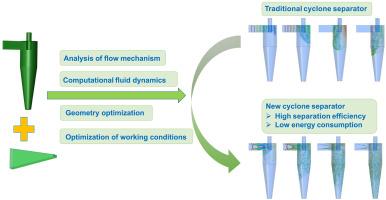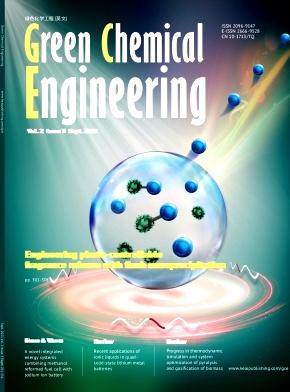新型旋风分离器性能优化和流动机理的数值研究
IF 9.1
Q1 ENGINEERING, CHEMICAL
引用次数: 0
摘要
本研究提出了一种新型旋风分离器,它在传统旋风分离器内部设计了一个喷嘴,在保持压降基本不变的情况下,显著提高了分离细颗粒的效率。首先,利用计算流体动力学(CFD)比较了新型旋风分离器与传统旋风分离器的流动特性。在此基础上,本研究全面考察了两种分离器在不同工作条件下的压降和分离效率。当入口速度为 2-10 m/s 时,新型分离器对粒径为 1 μm 的颗粒的分离效率比传统分离器高出约 45%。此外,当入口流速为 2 m/s 时,旋风分离器的压降保持不变,而分离效率却提高了 46%。分析了新型旋风分离器内部喷嘴出口面积对分离效率和压降的影响,并确定了综合性能最佳的喷嘴出口面积。结果发现,当喷嘴出口面积为 S/f = 2 cm 时,新型旋风分离器的整体性能最佳。最后,通过深入研究颗粒运动构型随时间的变化,开发出一种具有高分离效率的节能旋风分离器。值得注意的是,本研究为新型气固分离器的流场分析和几何优化提供了指导,而不仅限于旋风分离器。本文章由计算机程序翻译,如有差异,请以英文原文为准。

Numerical study on performance optimization and flow mechanism of a new cyclone separator
This study proposed a new cyclone separator, using a designed nozzle inside the traditional cyclone separator, which significantly improved the efficiency of separating fine particles while maintaining an essentially unchanged pressure drop. Firstly, computational fluid dynamics (CFD) was used to compare the flow characteristics of the new cyclone separator with those of the traditional cyclone separator. On this basis, this study comprehensively investigated the pressure drop and separation efficiency of two separators under varying working conditions. The new separator achieved a separation efficiency for particles with a particle size of 1 μm that was approximately 45% higher than that of the traditional separator when the inlet velocity was 2–10 m/s. Besides, the pressure drop of the cyclone separator remained unchanged while the separation efficiency increased by 46% at an inlet flow rate of 2 m/s. The influence of the outlet area of the nozzle inside the new cyclone separator on the separation efficiency and pressure drop was analyzed, and the outlet area of the nozzle with the best overall performance was determined. It was found that the overall performance of the new cyclone separator is optimal when the nozzle outlet area is S/f = 2 cm. Finally, an energy-saving cyclone separator with high separation efficiency was developed through an in-depth study of the variation of particle motion configuration with time. It is worth noting that this study provides a guidance for the flow field analysis and geometry optimization of new gas-solid separators, not limited to cyclone separators.
求助全文
通过发布文献求助,成功后即可免费获取论文全文。
去求助
来源期刊

Green Chemical Engineering
Process Chemistry and Technology, Catalysis, Filtration and Separation
CiteScore
11.60
自引率
0.00%
发文量
58
审稿时长
51 days
 求助内容:
求助内容: 应助结果提醒方式:
应助结果提醒方式:


